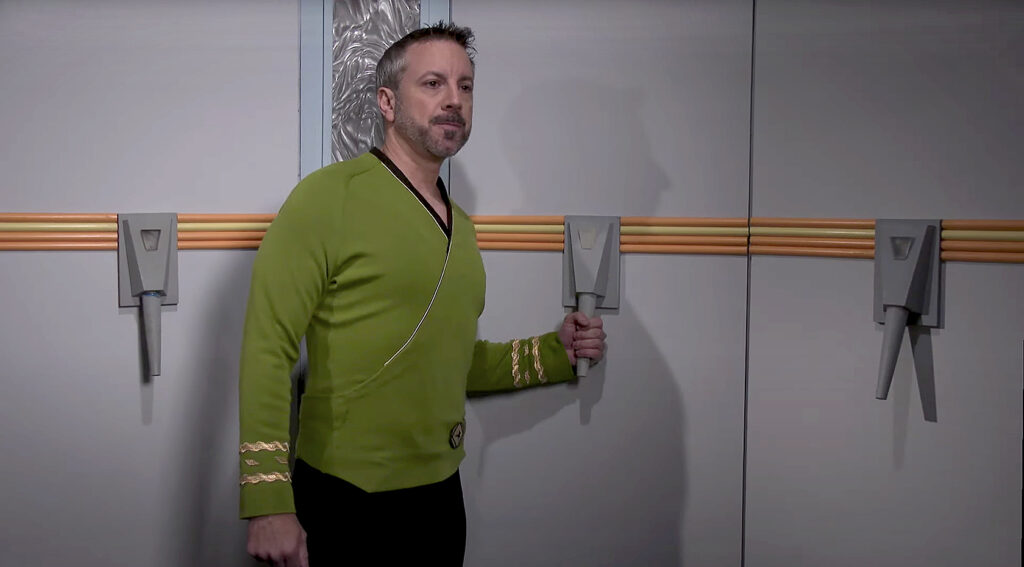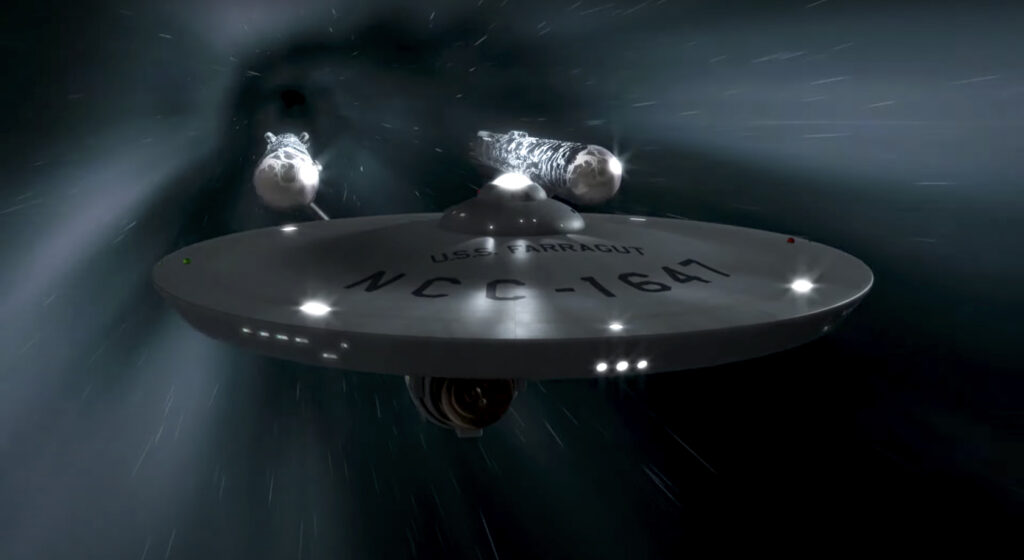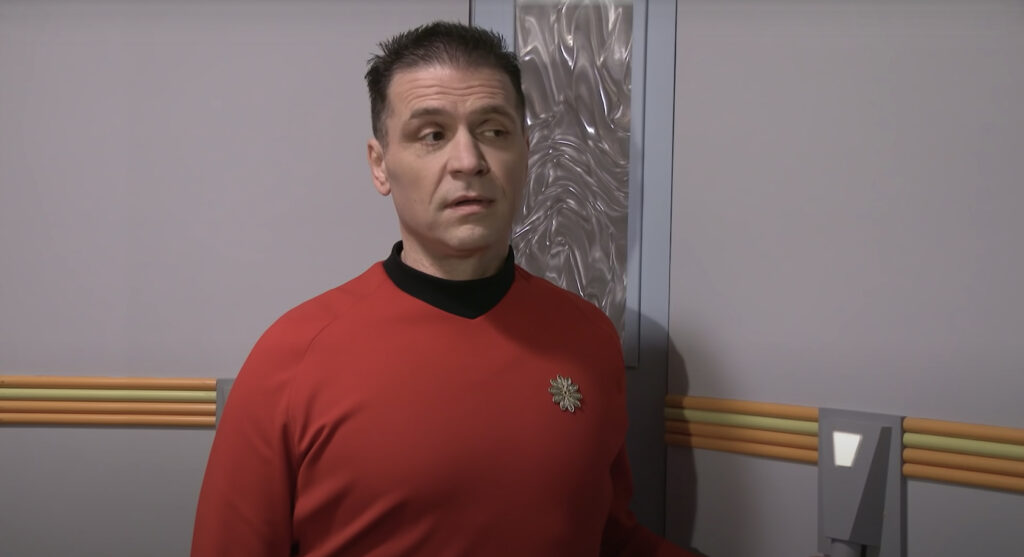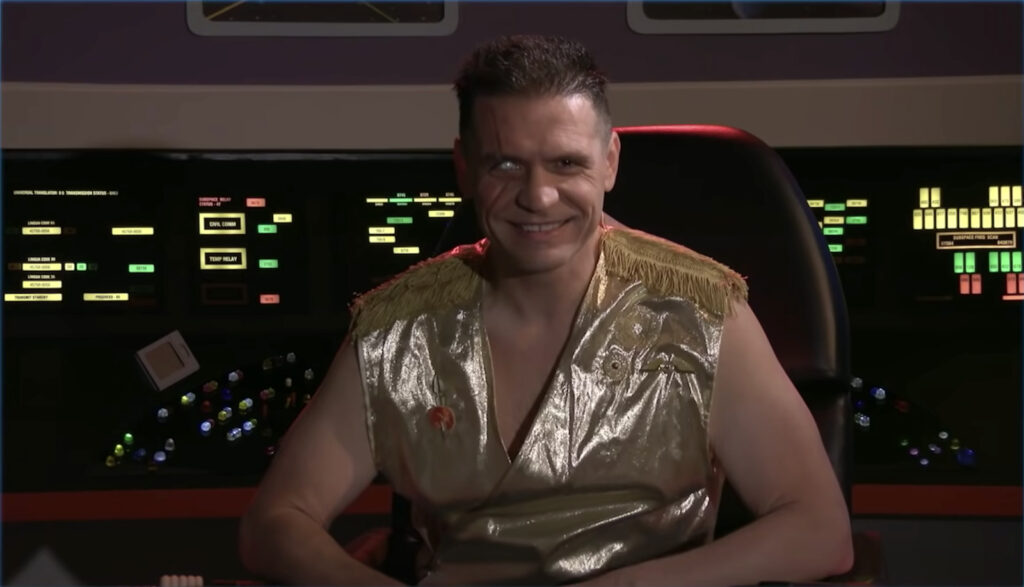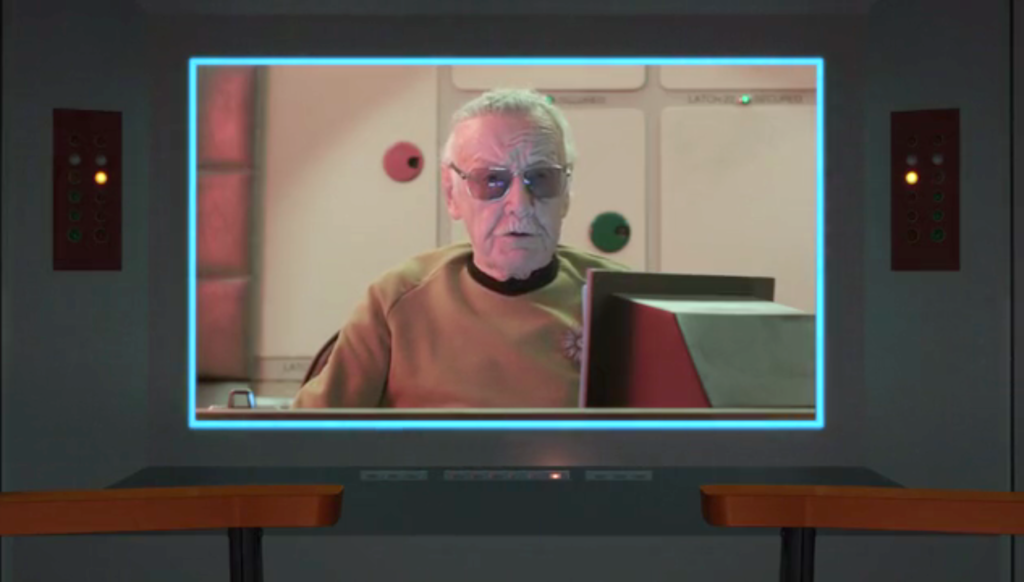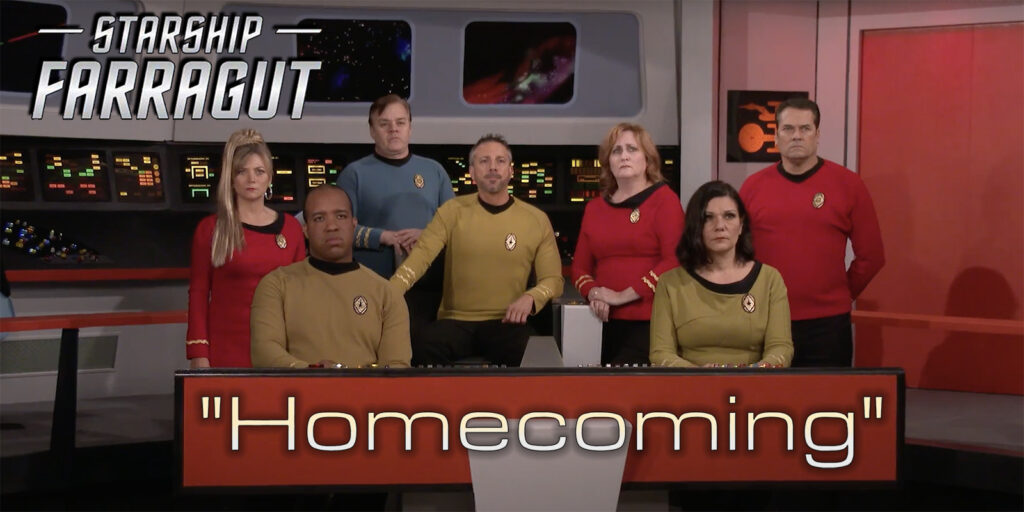
The history of the fan series STARSHIP FARRAGUT stretches all the way back to 2004 and spans a total of 6 full-length fan films, 3 shorter vignettes, and 2 animated-style fan films (one of them featuring the voices of TIM “Tuvok” RUSS and CHASE “Leeta” MASTERSON). Farragut Films was responsible for the majority of the construction of amazing TOS sets that were also utilized for STAR TREK CONTINUES and DREADNOUGHT DOMINION and are still available for use by fan filmmakers at NEUTRAL ZONE STUDIOS in Kingsland, GA. Farragut also spawned a short-lived spinoff series called TREK ISOLATION that released three vignettes. And coming in 2022, a sequel series titled FARRAGUT FORWARD will move some of the Starship Farragut characters into the Wrath of Khan movie era Trek.
Since we have so much material for today’s interview, I’ll keep the background introduction fairly brief. But if you’d like to read the full backstory of this proud fan series, here’s Part 1 of a 3-part deep-dive into the full history of Starship Farrugut. Well, ALMOST full. The final part of that blog feature came out in early 2016, a month before the release of their penultimate episode, “The Crossing,” and a few months before reshoots wrapped on their announced series finale, “Homecoming.” Crowd-funded with about $15K in late 2015, fans expected to see a completed fan film later in 2016 or maybe 2017. That didn’t happen.
Instead, it wasn’t until mid-2020 that STEVE SEMMEL announced that he was taking over as post-production supervisor, having started off simply doing the music for the episode. I interviewed Steve in June of last year, and he promised a delivery date in the second half of 2021 “most definitely.” And indeed, that’s exactly what happened, as “Homecoming” was released on October 1. Take a look…
I reached out to three people to discuss “Homecoming”: show-runner and lead actor JOHN BROUGHTON and writer PAUL R. SIEBER (both of whom have been with Starship Farragut since the very beginning), and of course, Steve Semmel (who came on board in 2018). We covered so much great behind-the-scenes information about both the finale episode and also going back to the earliest days of the series back in 2004.
I received so many awesome answers that I’ve decided to divide this interview into two parts. Let’s get started…
JONATHAN – Congratulations on a very strong series finale, guys! Let’s address the 800-pound mugato in the cave first: after so many releases in your first decade, why did this fan film take more than five years to finish?
JOHN – Although we had some issues getting ahold of the raw footage from our cinematographer, the biggest issue was that we had some volunteers—specifically the original composer and the CG artists—essentially punt on the project. So that and the missing footage were the major causes for our delay.
JONATHAN – What footage ended up missing?
JOHN – There’s stuff that gets mentioned about the Babylon that we don’t see. It was our B-story, but most of that footage wasn’t provided to us, even though we asked repeatedly. Eventually, Steve was given a hard drive that was supposed to have video files on it, but the drive was blank. And so we just had to make do with the copies of back-up footage I’d made, which didn’t include the Babylon stuff. So instead the characters just talk about what happened to that other crew.
The film was actually edited with the footage we had within about three weeks after we wrapped principal photography in mid-2016. We just had placeholders for all the FX shots. So it was really just getting the music and the special FX shots that took so long.
JONATHAN – But five years????
JOHN – Well, the thing was that we had trouble trying to find people to do the VFX for free. The people who were supposed to do it for us, we only had verbal agreements with, and they punted. And there was no money allocated for CGI work nor any money left from the crowd-funder after we wrapped production. So until Steve Semmel came along, we still had no VFX or anyone to do them.
JONATHAN – How did Steve solve that problem?
JOHN – He passed the hat around.
JONATHAN – Really? To whom?
STEVE – I convinced enough folks in the cast and crew to chip in a hundred or even just a couple bucks. Amazingly, I was able to raise quite a bit. This covered the special effects software license fees for MICHAEL STRUCK of NEO f/x, who was brought in to finish the VFX. Everyone who contributed is acknowledged in the final credits as a Visual Effects Producer…including myself.
JONATHAN – So this didn’t happen until after you came on board in…?
STEVE – September 2019. And I’d only discovered Star Trek fan films for the first time in 2018, but I quickly went from being a complete outsider who’s been living under a rock for 15 years to being the most enthusiastic person on the post production team.
JONATHAN – As I recall, Steve, you were originally going to be handling just the music, right?
STEVE – Yes, but it quickly become evident that if I (or someone) didn’t step up and otherwise fill the role vacated by the original director, SCOTTY WHITEHURST, “Homecoming” was doomed. So I took over as Post-Production Supervisor.
JONATHAN – And what did that new role entail for you, Steve?
STEVE – I remember telling you in the interview last year that “a post-production supervisor bugs everybody all the time about everything.” Well that did not stop for one minute right up until the very end. In fact, it escalated, and I became even more of a pain in the ass to everyone since we last talked.
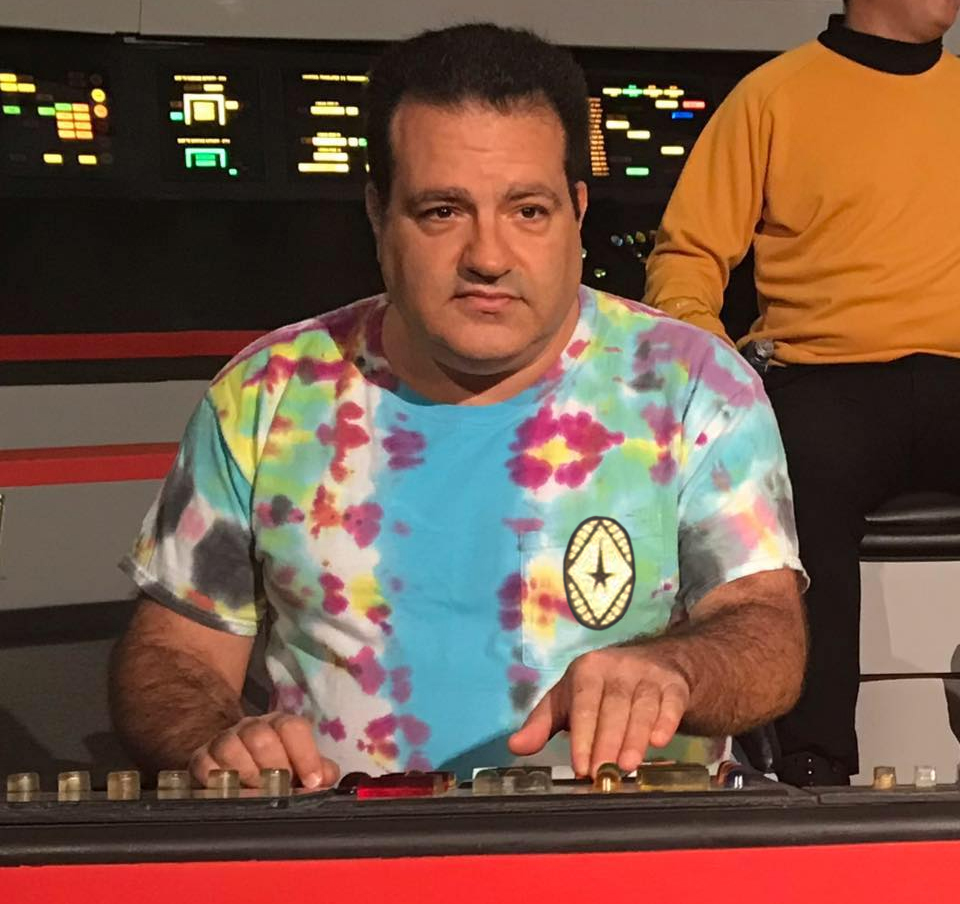
At first, he process entailed mainly a lot of communicating with people I’ve never met before, trying to gain their confidence and get them to help. There’s a lot that I had to learn. I had a lot of questions, and I had no idea who to start asking. There was a lot of chipping away I had to do, but finally some folks started coming forward and volunteering to help. I really appreciated that and all the folks who assisted me for the last two years.
JONATHAN – What post-production tasks were you doing yourself versus what were you only supervising?
STEVE – All of the visual effects, I supervised. Everything else I had a hand in. I did some of the sound editing myself. I did lots of screenplay editing also, and I’m just realizing now that I forgot to credit myself for that in the final credits! I was also responsible for compiling the final credits. That was a royal pain in the ass…considering I didn’t know anybody. But I had a lot of help, thank heaven.
JONATHAN – So, Steve, were you the “boss” during post-production or did you report to a higher authority?
STEVE – No, John was the boss at all times. Everyone in the cast and crew was involved. Being the newbie, I telegraphed all of my progress and activities in minute detail to everyone in the Facebook private group all the times. If I was doing anything blatantly stupid or wrong, I would hear about it, and I sometimes did! Ultimately, producer JAY PENNINGTON was the voice of authority and final approver of everything. Jay won all the arguments.
JONATHAN – Okay, Paul hasn’t had a turn yet, so let me ask the writer: When you first wrote the script for “Homecoming,” did you already know that it was going to be the series finale before you began working on it? Or was the script already done or in process when your team decided to end the series (and you just added the STAN LEE epilogue)?
PAUL – John actually intended “The Crossing” to be the end, but I felt it had too many open threads. I wanted to close out the story of Captain Carter, not with a bang, but with a swan song. I thought that with so many years of loyal fans, they deserved an epilogue, of sorts, and the story for “Homecoming” was born on the drive home with CASE AIKEN in my car from the shoot for “The Crossing.” By the time I got back to DC, the story was locked in my head, and I got it on paper very quickly.
The ending was set in stone. John was interested, at that time, in doing Farragut Forward, and I wanted to close out Farragut. I think one of the only debatable items was what we’d be for the new ship, and we both agreed that the next Farragut would be entirely new…no A, B, etc. Only Enterprise had that possibility. I remember proposing the idea of the Miranda class ship, solely because I thought the bridge set looked smaller on film, and I thought it would be easier for John to build. We also both noted the Farragut seen at the end of Generations, so it seemed appropriate. The Stan Lee cameo was great, but had it not been Stan, then another admiral would have given the order, perhaps even bringing back the admiral from “The Captaincy.”
I think the only item in question was the fate of Prescott. John wanted him to live, but I only agreed to bring him back in “The Crossing” to kill him off. I kinda surprised John with the post credits scene with the Romulan ship, but honestly, I never intended to do anything with it.
After a while, however, the idea intrigued me, so I added the post credits scene in “Homecoming.” At that time, I began the draft of a 2-hour Farragut Forward movie, which, unfortunately, won’t ever be completed. It was extremely ambitious, but would have been an incredible ride. And who knows? Maybe some elements of it will work their way into Farragut Forward someday.
JONATHAN – So are you satisfied that you gave Starship Farragut a proper ending?
PAUL – If you look at“The Price of Anything,” “The Crossing,” and “Homecoming,” they are one long story but pull in elements and story concepts from “For Want of a Nail,” “Conspiracy of Innocence,” and the animated episodes, and even the comic book. You can watch them independently, but if you followed Farragut as a series, the stories are richer and more meaningful.
I feel, as a writer, I got better when I took my character out of the loop and focused on the “core 3” of Carter, Tacket, and Smithfield. In the tales I wrote, I wanted to make them human, give them flaws, allow people to relate to them, and show that what they did had consequences. In fact, “Homecoming” is entirely about that. As a closing episode, it is intended to sum up the years of previous Farragut adventures, told and untold. Carter had a tough ride…and it should have taken a toll on him as a person. I wanted to show that, and I feel that’s what we did. So yes, I’m very satisfied.
JONATHAN – Okay, I’ve just gotta ask John this question: how in heck did you get the legendary STAN LEE to appear in your fan film???
JOHN – Um, no comment.
JONATHAN – Seriously??? That’s the one question everyone wants to hear the answer to!
JOHN – I’m sworn to secrecy!
JONATHAN – Well, so much for my big scoop! But can you tell us anything about working with Stan? Was he excited to appear in a Star Trek fan film, or was it just something he wanted to get it over with?
JOHN – Oh, he was totally into it. And I will say this: they say don’t meet your heroes because they’ll be disappointments. But Stan Lee…he was everything and more. He was just as genuine, as gracious, as humble…just the nicest guy. It was probably the greatest experience of meeting an influencer, and Stan was one of my three greatest inspirations growing up, along with IAN FLEMING and GENE RODDENBERRRY. As a kid, I was always drawing Spider-Man, I was such a fan. And meeting Stan Lee was just the greatest experience of all.
In fact, the script had his character calling Carter “John” and not “Jack” (just like Kennedy, his formal name was John but everyone called him Jack). In doing so, Stan was calling my character John, not so much to make it formal, but on a personal level, it’s Stan Lee talking to me. So that interaction is more Stan connecting with me than with Captain Carter.
JONATHAN – That’s a wonderful story, John. So did Stan get to see any of the footage of him before he passed away?
JOHN – Yes, my understanding was that it was shown to him. A clip of that segment was used as a teaser trailer and released on the Internet prior to him passing away. I suspect that he enjoyed seeing himself as a Starfleet Admiral.
JONATHAN – Now, there was another person associated with your production who passed away before it was completed: Star Trek author DAVE GALANTER, who served as script editor. Did he get to see any of the film?
PAUL – Dave Galanter was a dear friend and a great writer. He really helped me learn where my screenplays needed change and made me better. Sadly, he did not get to see any of the film. On a side note, he did write the guest-starring role of Kyril—that I played in Star Trek New Voyages‘ “Enemy- Starfleet!”—specifically for me. AND…in his last Trek novel, Troublesome Minds, a new character pops up in a couple scenes: none other than Lt. Commander Henry Prescott.
JONATHAN – That’s cool…your Farragut character has been immortalized in Star Trek literary lore!
Now, you also had another celebrity, of sorts, in your cast: DICK DYSZEL, who was actually the second person ever to play the character of Bozo the Clown (the first was the late WILLARD SCOTT, who was also the first-ever Ronald McDonald, believe it or not!). How did you manage to bring Dick in to do a Star Trek fan film?
PAUL – That was me. I’ve known Dick for many years, after meeting him at a convention where he (as Count Gore) was interviewing JAMES CAWLEY about New Voyages, and we became friends, crossing paths on a couple local Washington, DC area films. I knew he was a Trek fan, and I mentioned him to John as a celebrity that had a huge following and could be great to have in the film—and that he was also a terrific actor to boot. John seemed to think he had a great look and allowed me the honor of asking him to join us. That conversation took five minutes, and Dick just wanted to know when and where!
Funny side story: my wife grew up in the DC area, and as a kid watched the local Saturday TV cartoon and kids show host, Captain 20 (also played by Dick Dyszel, before he played Count Gore). We set up shop at my house in preparation to film the scenes at Pope-Leighey House (as it was close by), and I mentioned to her about Dick (she heard me refer to him as Count Gore) and asked what else he had done. When I mentioned Captain 20, she went through the roof, and could not understand how I never told her I was friends with Captain 20! That was her childhood!
JONATHAN – The final song over the closing credits, Remember Me (which sounds awesome!), is hauntingly beautiful. Did AMY BERRY write it specifically for “Homecoming”?
PAUL – Yes. Amy is an amazing DC area talent. I met her through some other friends, and noted her musical style and ability to write was untapped in the local film community. I thought that should change. With this being the final Farragut, I talked to John about doing something different, and like a film, having a real song with lyrics composed and added to the film. We could also tie in a music video and promote local talent, as well. I introduced him to her music, and he readily agreed.
I gave Amy a copy of the early draft of the film and began talking to her about the idea. We didn’t have a budget to pay her, but we’d create a music video in exchange. She liked the idea. After reading the screenplay, she really glommed onto the character of Hope and the line “Remember me.” So she went from there and wrote a beautiful, haunting, and spot-on song for the film. I think it works amazingly well and only wish we’d have done something similar before to maybe showcase her more…or even other local bands! No fan film had done anything like this, and as it was the last episode of a series that broke ground in so many ways (long span, animated adventures, comics)…it seemed appropriate that we ended by breaking new ground again!
JONATHAN – Shifting from the ending to the beginning, I’d like to ask you guys a little bit about the very early days of Starship Farragut. And the first thing I’ve always wondered: what made you choose the U.S.S. Farragut rather than one of the other major starships like Potemkin or Lexington or Republic?
Tomorrow in the conclusion – We get some insights into the earliest days of Starship Farragut and also its lasting legacy. Then we finish up with more behind-the-scenes info on “Homecoming” and some final thoughts from our fan filmmakers.

